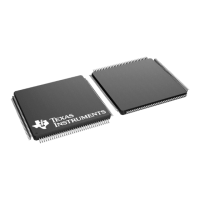www.ti.com
Usage Notes and Known Design Exceptions to Functional Specifications
39
SPRZ412K–December 2013–Revised February 2020
Submit Documentation Feedback
Copyright © 2013–2020, Texas Instruments Incorporated
TMS320F2837xD Dual-Core MCUs Silicon Revisions C, B, A, 0
Advisory GPIO: Open-Drain Configuration May Drive a Short High Pulse
Revision(s) Affected 0, A, B, C
Details Each GPIO can be configured to an open-drain mode using the GPxODR register.
However, an internal device timing issue may cause the GPIO to drive a logic-high for up
to 0–10 ns during the transition into or out of the high-impedance state.
This undesired high-level may cause the GPIO to be in contention with another open-
drain driver on the line if the other driver is simultaneously driving low. The contention is
undesirable because it applies stress to both devices and results in a brief intermediate
voltage level on the signal. This intermediate voltage level may be incorrectly interpreted
as a high level if there is not sufficient logic-filtering present in the receiver logic to filter
this brief pulse.
Workaround(s) If contention is a concern, do not use the open-drain functionality of the GPIOs; instead,
emulate open-drain mode in software. Open-drain emulation can be achieved by setting
the GPIO data (GPxDAT) to a static 0 and toggling the GPIO direction bit (GPxDIR) to
enable and disable the drive low. For an example implementation, see the code below.
void main(void)
{ ...
// GPIO configuration
EALLOW; // disable pullup
GpioCtrlRegs.GPxPUD.bit.GPIOx = 1; // disable open-drain mode
GpioCtrlRegs.GPxODR.bit.GPIOx = 0; // set GPIO to drive static 0 before
// enabling output
GpioDataRegs.GPxCLEAR.bit.GPIOx = 1;
EDIS;
...
// application code
...
// To drive 0, set GPIO direction as output
GpioCtrlRegs.GPxDIR.bit.GPIOx = 1;
// To tri-state the GPIO(logic 1),set GPIO as input
GpioCtrlRegs.GPxDIR.bit.GPIOx = 0;
}

